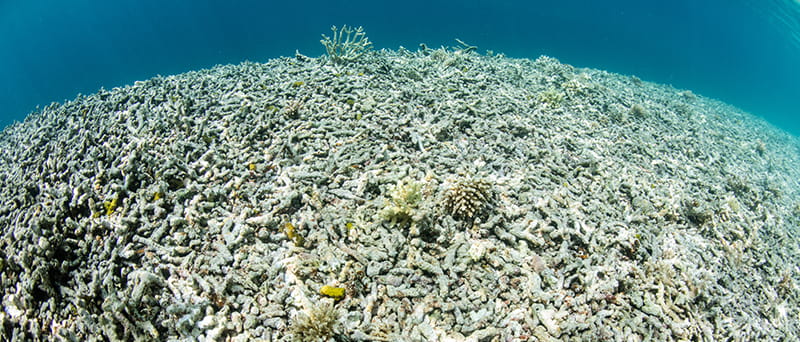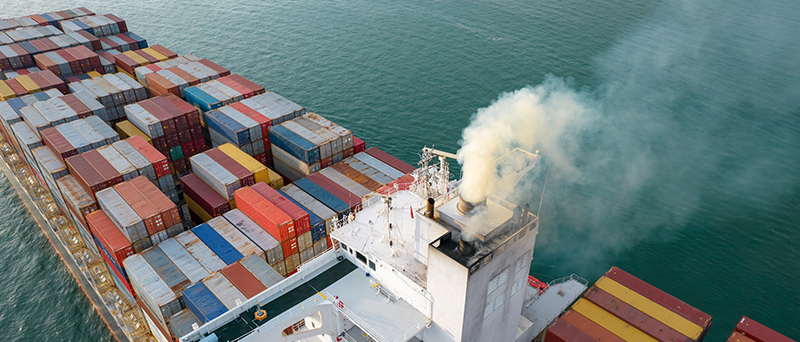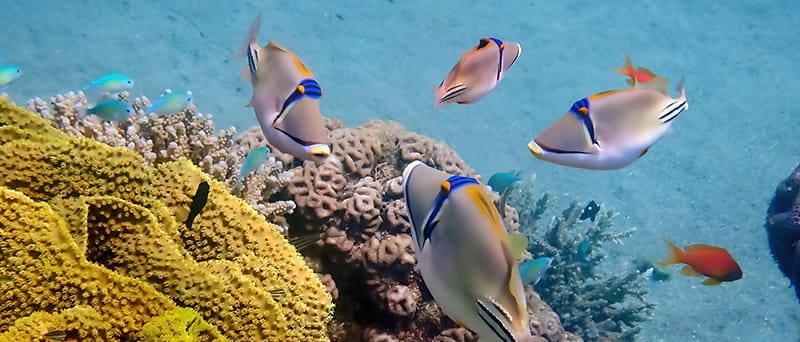Read the latest thoughts and analysis on breakthrough solutions driving impact for a sustainable future
Getting on board with net-zero: the new framework for decarbonizing shipping

For centuries, the seas have served as the arteries of global trade, connecting countries, building economies and shaping civilizations. Yet underneath the waves lie fragile ecosystems under increasing strain from the titanic vessels on the surface.
Emissions from ships lead to ocean acidification, damaging coral reefs, polluting waters and threatening countless marine species. They pose major health risks to coastal communities and people who make their living on the water. Black particles from shipping also land on sea ice, accelerating Arctic ice melts and setting off a grim climate change feedback loop. In short, the vessels that rely on the ocean to transport goods are slowly destroying it.

The shipping industry now finds itself navigating uncharted waters: decarbonizing without compromising vital trade. Accomplishing this calls for more than band-aid solutions. The sector will need structural reform, refashioning infrastructure and rethinking norms.
After years of negotiations, the International Maritime Organization (IMO) has made major strides by laying out its Net-Zero Framework, putting sustainability on the manifest.
What does the framework do?
The new framework was agreed upon at the April meeting of the UN IMO Marine Environment Protection Committee. It aims to cut greenhouse gas emissions from shipping to net-zero by 2050, in line with the Paris Agreement.
This will involve a two-pronged approach, introducing a mandatory fuel standard and a carbon pricing mechanism for the shipping industry. These will apply to the largest ships (above 5,000 gross tonnage) which are collectively responsible for 85% of the industry’s CO2 emissions.

The mandatory fuel standard will encourage a reduction in greenhouse gas fuel intensity (GFI), accounting for the full lifecycle emissions of shipping fuels. It takes a “fuel agnostic” approach which does not consider fuel or feedstock type.
The two-tier carbon pricing mechanism will require ships with emissions above certain GFI thresholds to buy credits. They must pay $380 per tonne of CO2 equivalent for emissions in excess of the base limit and $100 per tonne of CO2 equivalent for emissions between the base limit and the more ambitious “Direct Compliance Target.” Ships with GFI below this second threshold will earn credits which can be saved or sold. Both thresholds will be increased annually. Revenue from the mechanism will go towards an IMO Net-Zero Fund, which will be partially used to fund climate resilience measures in countries vulnerable to climate change impacts, including Small Island States.
The framework is set to be formally adopted in October 2025, with detailed guidelines to follow in 2026. It will then come into force in 2027.
Why does it matter?
If properly implemented, the framework will incentivize investments in low- and zero-carbon shipping fuels while raising much-needed funds for climate mitigation and resilience.
This is especially important because shipping is an industry with no straightforward path to decarbonization: a “hard-to-abate" industry.
Global trade depends largely on vast vessels powered by energy-dense fossil fuels. These are responsible for around 3% of overall emissions. These ships are too large to be powered by batteries, and it will take time to scale up capacity of low- and zero- carbon fuels such as green methanol, ammonia, hydrogen, and biofuels. Scaling up these fuels, establishing the corresponding supply chains, and replacing existing vessels with appropriate next-generation models will be a great undertaking.
While the scale of the challenge ahead is tremendous, the new framework provides a common path for the shipping industry to follow towards its 2050 goal of net-zero greenhouse gas emissions. It is undoubtedly an ambitious plan – if adopted later this year, it would set the first global carbon price for any industry – but ambition is exactly what the situation calls for.
Innovation beyond fuel
There is a well-recognized need for the industry to continue investing in the scaling up of sustainable shipping fuels – e.g., with innovations to reduce the energy consumption of electrolysis, the process through which green hydrogen is manufactured.
However, the industry could also benefit from innovations unrelated to sustainable fuels. A new Age of Sail could be on the way, with a cargo ship equipped with rigid sails – which cut fuel consumption – setting off on its maiden voyage in 2023. Companies have also experimented with installing carbon capture technology on board, lubricating the hulls of ships with air bubbles, and many other unexpected innovative ideas.
Just one piece of the puzzle
While the framework is cause for celebration, it is not an end in itself. Many challenges lie ahead: from the formal adoption process later this year (which will require a two-thirds majority) to ensuring that this unprecedented framework is effectively and fairly implemented over the coming decades. This will require the sector to agree upon a standardized methodology for reporting emissions.
It is also important to ensure that the framework does not have unintended impacts which compromise its mission to reduce greenhouse gas emissions. Researchers from the International Council on Clean Transportation, for instance, propose a number of adjustments to account for other climate impacts such as land-use changes from biofuels and emissions of methane, nitrous oxide, and black carbon.
As the framework comes into effect, it cannot be used as an excuse for complacency in other areas of environmental action. The oceans face multiple threats: biodiversity loss, plastic pollution, and many others. Without strong safeguards, deep-sea mining could also severely damage fragile marine ecosystems and erase species yet to be discovered. The US’ recent withdrawal of its support for international negotiations on deep-sea mining regulations, for example, has left a regulatory vacuum just as commercial interest in extracting valuable metals from the seafloor is growing.
Tackling these threats will require sustained, holistic action that spans beyond the shipping industry. Deep-sea mining will be a key topic at the 2025 UN Ocean Conference in Nice, France, for example, where nations are expected to strengthen commitments to ocean protection. With rising interest in deep-sea mining, the conference offers a timely opportunity to align marine conservation with sustainable ocean use.
Actions on the ground are just as crucial to addressing threats to the health of the world’s oceans. The Environment Agency – Abu Dhabi, for example, recently announced a major initiative, the Abu Dhabi Coral Gardens project, to protect and restore the emirate’s marine environment. This will create underwater “gardens” by installing 40,000 artificial corals to support the growth of marine organisms.

This is just one example of the kind of innovative initiative that will be required alongside the IMO Net-Zero Framework to protect the oceans.
Reaching an agreement on the new IMO framework is a major milestone for climate mitigation. If successfully implemented, it will help this hard-to-abate industry shift towards carbon neutrality by incentivizing investment in sustainable fuel technologies. Alongside continued marine conservation efforts, it presents the promise of a better future for our oceans.
Emissions from ships lead to ocean acidification, damaging coral reefs, polluting waters and threatening countless marine species. They pose major health risks to coastal communities and people who make their living on the water. Black particles from shipping also land on sea ice, accelerating Arctic ice melts and setting off a grim climate change feedback loop. In short, the vessels that rely on the ocean to transport goods are slowly destroying it.

The shipping industry now finds itself navigating uncharted waters: decarbonizing without compromising vital trade. Accomplishing this calls for more than band-aid solutions. The sector will need structural reform, refashioning infrastructure and rethinking norms.
After years of negotiations, the International Maritime Organization (IMO) has made major strides by laying out its Net-Zero Framework, putting sustainability on the manifest.
What does the framework do?
The new framework was agreed upon at the April meeting of the UN IMO Marine Environment Protection Committee. It aims to cut greenhouse gas emissions from shipping to net-zero by 2050, in line with the Paris Agreement.
This will involve a two-pronged approach, introducing a mandatory fuel standard and a carbon pricing mechanism for the shipping industry. These will apply to the largest ships (above 5,000 gross tonnage) which are collectively responsible for 85% of the industry’s CO2 emissions.

The mandatory fuel standard will encourage a reduction in greenhouse gas fuel intensity (GFI), accounting for the full lifecycle emissions of shipping fuels. It takes a “fuel agnostic” approach which does not consider fuel or feedstock type.
The two-tier carbon pricing mechanism will require ships with emissions above certain GFI thresholds to buy credits. They must pay $380 per tonne of CO2 equivalent for emissions in excess of the base limit and $100 per tonne of CO2 equivalent for emissions between the base limit and the more ambitious “Direct Compliance Target.” Ships with GFI below this second threshold will earn credits which can be saved or sold. Both thresholds will be increased annually. Revenue from the mechanism will go towards an IMO Net-Zero Fund, which will be partially used to fund climate resilience measures in countries vulnerable to climate change impacts, including Small Island States.
The framework is set to be formally adopted in October 2025, with detailed guidelines to follow in 2026. It will then come into force in 2027.
Why does it matter?
If properly implemented, the framework will incentivize investments in low- and zero-carbon shipping fuels while raising much-needed funds for climate mitigation and resilience.
This is especially important because shipping is an industry with no straightforward path to decarbonization: a “hard-to-abate" industry.
Global trade depends largely on vast vessels powered by energy-dense fossil fuels. These are responsible for around 3% of overall emissions. These ships are too large to be powered by batteries, and it will take time to scale up capacity of low- and zero- carbon fuels such as green methanol, ammonia, hydrogen, and biofuels. Scaling up these fuels, establishing the corresponding supply chains, and replacing existing vessels with appropriate next-generation models will be a great undertaking.
While the scale of the challenge ahead is tremendous, the new framework provides a common path for the shipping industry to follow towards its 2050 goal of net-zero greenhouse gas emissions. It is undoubtedly an ambitious plan – if adopted later this year, it would set the first global carbon price for any industry – but ambition is exactly what the situation calls for.
Innovation beyond fuel
There is a well-recognized need for the industry to continue investing in the scaling up of sustainable shipping fuels – e.g., with innovations to reduce the energy consumption of electrolysis, the process through which green hydrogen is manufactured.
However, the industry could also benefit from innovations unrelated to sustainable fuels. A new Age of Sail could be on the way, with a cargo ship equipped with rigid sails – which cut fuel consumption – setting off on its maiden voyage in 2023. Companies have also experimented with installing carbon capture technology on board, lubricating the hulls of ships with air bubbles, and many other unexpected innovative ideas.
Just one piece of the puzzle
While the framework is cause for celebration, it is not an end in itself. Many challenges lie ahead: from the formal adoption process later this year (which will require a two-thirds majority) to ensuring that this unprecedented framework is effectively and fairly implemented over the coming decades. This will require the sector to agree upon a standardized methodology for reporting emissions.
It is also important to ensure that the framework does not have unintended impacts which compromise its mission to reduce greenhouse gas emissions. Researchers from the International Council on Clean Transportation, for instance, propose a number of adjustments to account for other climate impacts such as land-use changes from biofuels and emissions of methane, nitrous oxide, and black carbon.
As the framework comes into effect, it cannot be used as an excuse for complacency in other areas of environmental action. The oceans face multiple threats: biodiversity loss, plastic pollution, and many others. Without strong safeguards, deep-sea mining could also severely damage fragile marine ecosystems and erase species yet to be discovered. The US’ recent withdrawal of its support for international negotiations on deep-sea mining regulations, for example, has left a regulatory vacuum just as commercial interest in extracting valuable metals from the seafloor is growing.
Tackling these threats will require sustained, holistic action that spans beyond the shipping industry. Deep-sea mining will be a key topic at the 2025 UN Ocean Conference in Nice, France, for example, where nations are expected to strengthen commitments to ocean protection. With rising interest in deep-sea mining, the conference offers a timely opportunity to align marine conservation with sustainable ocean use.
Actions on the ground are just as crucial to addressing threats to the health of the world’s oceans. The Environment Agency – Abu Dhabi, for example, recently announced a major initiative, the Abu Dhabi Coral Gardens project, to protect and restore the emirate’s marine environment. This will create underwater “gardens” by installing 40,000 artificial corals to support the growth of marine organisms.

This is just one example of the kind of innovative initiative that will be required alongside the IMO Net-Zero Framework to protect the oceans.
Reaching an agreement on the new IMO framework is a major milestone for climate mitigation. If successfully implemented, it will help this hard-to-abate industry shift towards carbon neutrality by incentivizing investment in sustainable fuel technologies. Alongside continued marine conservation efforts, it presents the promise of a better future for our oceans.
More Articles
27 NOVEMBER 2025
Energy Transformation
From pledge to policy: how the UAE is turning climate ambition into action
26 NOVEMBER 2025
Decarbonization


